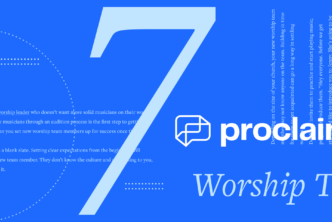Your follow-up plan for visitors isn’t a biannual program you turn on before Christmas and Easter. Those are obviously the weekends you can expect the most newcomers, but your church should always be refining the journey from visitors to members.
There are plenty of things you can do during the service to make people feel welcome, and ways you can cater your sermons to newcomers, but even if you do all of that perfectly, and your church looks and feels exactly how you’ve always imagined it would, that doesn’t guarantee people will come back the next week. Your follow-up plan should be a well-oiled machine that follows new people out the door and brings them back.
If it takes two weeks for your church to reach out to new people, you’re losing some of them.
If you’re collecting contact information you aren’t using, you’re losing some of them.
If people can read your email or talk to you on the phone without knowing what you want them to do next, you’re losing some of them.
You’ll always find exceptions, and there are plenty of other factors, but if any of the problems above apply to your church, your follow-up plan may as well be a placebo.
If your church can’t seem to hold on to newcomers, here are four ways you can bring more of those newcomers back next week:
1. Follow up in a timely manner
Don’t give visitors enough time to forget you before reaching out to them.
Follow up should begin while your service is still fresh in someone’s mind. If people give you their contact information, they’re expecting you to contact them. If you wait too long to call, email, or mail them, you’re starting your relationship as the flaky friend nobody can count on. No matter how much you enjoy the company of a flaky friend, it doesn’t take very long before the relationship is too much work, or too unreliable to maintain.
And let me just say right now, when people give you their mailing address, they are expecting mail, not strangers on their door step.
I get it. Real relationships with real people are the biggest thing that bring people back to church. And you’ll start to develop some of those if you show up at their house after church. But for the vast majority of people, that’s not a natural way to start a relationship with someone. Is there any other context where that is an interaction that people expect or desire to have?
Unless you are clearly communicating to people that someone from the church will drop by to say hello and bring them a gift, don’t do it. If you intend to follow up with visitors in person, at their homes, you should prayerfully consider whether you have the right demographics and an appropriate plan for what those visits look like. To some people, it’s a nice gesture. To others, it’s a major red flag—like a clingy first date.
An email, a phone call, a text, or a letter in the mail is a much more appropriate next step after someone gives you their contact information. It’s not as big of a gesture to some people, but that’s okay—it’s not as big of a turn-off either.
Following up with new people each week should be a priority for your church. If no one on your staff can personally devote the time to it, maybe it’s time to recruit some volunteers specifically for that purpose.
2. Set reasonable expectations
Before you ever ask someone for their contact information, you should know exactly how you intend to use it. If you don’t have a plan for how you will use someone’s phone number, email, or mailing address, don’t ask for it.
You might be tempted to think “this may come in handy some day,” but asking for too much information up front can make “keeping in touch” feel like too big of a commitment. You’ll wind up with lots of information about less people. This is about bringing as many people back as possible, not finding out who is most eager to connect with you.
You’re trying to develop a long-term relationship. A very small percentage of people might be ready for a proposal on the first date if everything went perfectly, but let’s be honest—even if they had an amazing time, how would most people react to that?
When you can tell people exactly how you intend to use their email, phone number, or address, you establish trust. It removes any questions people have about what will happen next, and directly addresses their hesitancy to give you that information in the first place. More than that though, it tells you something about the people who sign up: they want you to do a specific thing with their contact information.
This is about finding an appropriate way to “get your foot in the door.” Once you’ve done what you said you would do with their contact information, you can give them the opportunity to tell you how they’d like to continue staying in touch. They can opt-in to a new email or mailing list. They can schedule a meeting with a staff person, a small group leader, or a group of other new people.
The more people know about what it means to give you their information, the easier it is for them to give it to you.
You can (and should) communicate your intentions in the church bulletin, in the same place you ask for their information, and then whoever shares your announcements can help cast the vision for what you’ll be sharing with new people.
If your church calls new people, tell them what you’ll call them about and why they should look forward to that phone call. If you email new people, explain the benefits of being on this list. However your church follows up with new people, set yourself up for success by casting the vision for what happens next.
People make a lot of assumptions about what’s an appropriate use of someone’s contact information. Should you email them once a week, every two days, or once a month? How soon is too soon to call them? Mail them? Invite them to something else?
When you set clear, reasonable expectations for how you will use someone’s contact information, there’s no ambiguity.
3. Provide a clear next step
When someone first sets foot in your door, you probably don’t know much about them. You don’t know where they’re at spiritually—this could be the first time they stepped inside a church, or they could be a former pastor, an atheist, or anything in between. You can’t make assumptions about what they believe or what groups, ministries, or opportunities they’re ready for.
When in doubt, talk to the furthest out.
I’ve been volunteering in an outreach ministry for seven years, so I’m a little biased, but when you’re speaking to large groups of people who could be in very different places spiritually (like on an email list), it’s always safer to start with the absolute basics.
For your church, this means identifying the simplest next step. During the service, you might direct new people to a particular booth or person, where they can receive a free gift. Or maybe you prefer to mail people a gift (which creates more incentive for them to give you their address). If your primary goal is to help new people develop relationships, maybe you direct them to an event catered to new people, or a small group, or a meeting with a staff person who can afford to invest in the relationship.
Maybe it’s as simple as getting them to come again next week.
Whatever your ideal next step is, it should be designed for people who are completely new to your church, and it should be completely clear what you’d like them to do. Pick the most appropriate next step and focus your efforts on directing people to take that action. At most, include one secondary action you’d like people to take if they aren’t ready to take the ideal next step you’ve selected.
Giving people too many choices is almost as bad as giving them none.
4. Make it personal
When a new person gives you their contact information, that information shouldn’t go into some random pool of member info, and they probably shouldn’t receive your weekly newsletter. Whatever you send them should be specially-catered to someone who just came to your church for the first time—because that’s who they are.
All they know about your church is probably what you showed them during your last service, so you should talk to them like someone you just met, not like a 30+ year member of your church.
Maybe you can introduce them to your staff, with a letter explaining a little more about the pastor they just heard preach. Or an explanation of your church’s mission—why you exist, and what you hope your church can be for this new person. Or some of the best ways to get to know people at your church.
Your “new people” email/mailing/calling lists should have a clear, straightforward progression that addresses where people are at when they leave the door of your church, and helps carry them back the next week, and the next week, and the next week.
Use their names. Talk to them like real people. Show them what your church is all about. Not a generic, cookie-cutter creed, mission statement, or calling. Tell them about the people at your church. The story of your church.
People will come back to your church because of the people. That’s what your church really is, after all. When you’re trying to show visitors what your church is like, show them what your people are like.






